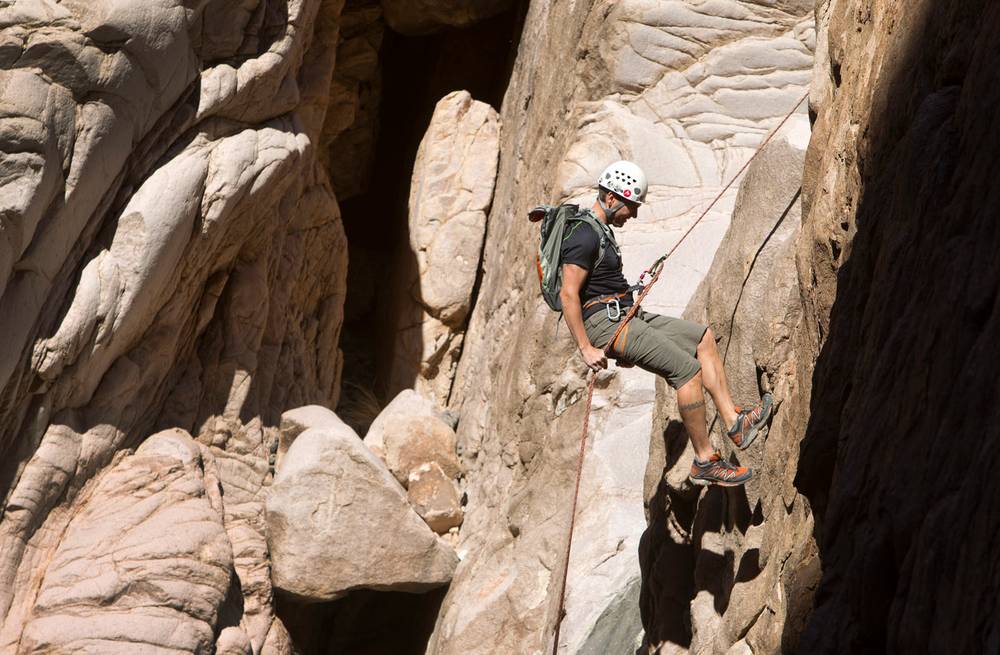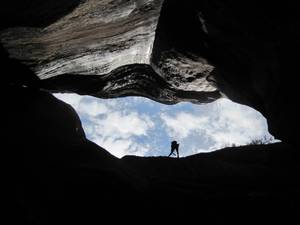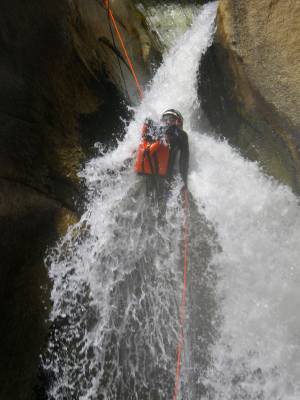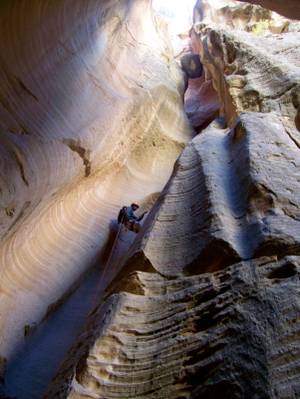The Outdoor Issue
- The beautiful, technical, secret worlds of canyoneering
- The hunger of a man denied: Will Swope eyes the Spartan Race podium
- Air Force S.E.R.E. Specialists are masters in the art of survival
- Fireside fare: Chef Charlie Palmer has your recipe for stellar camp cuisine
- Inside the photos of adventure junkie Cameron Grant
- Gear to outfit your dog with for your next hiking adventure
- Hit the trail: Our guide to 10 of the Las Vegas Valley’s best routes
- Gear up: 5 essentials (and sexy upgrades) for the great outdoors
- A city girl in hot water: Exploring some nearby hot springs
- Fun runs that are actually fun
“We boogied. No frills, no talking. Just get through it,” Mike Harcarik says. He and two friends were deep in a slot of Zion National Park’s Spry Canyon when they heard thunder. They knew that if a storm unleashed, the channel of rock could transform into a washing machine. And that’s exactly what happened.
Mike and his group felt the first raindrops just as they reached the open wash, scrambling as high as they could and holing up behind a boulder. For an hour they watched the rain pound into a flood funneling right to the tree that would have anchored their next rappel. “Had we not decided to stop, we would have been dead,” he says. “There were about 50 cars stopped on the other side of the highway below the tunnel, and they weren’t watching us. What they were watching was this phenomenal, 100-foot waterfall.”
The group behind them wasn’t so lucky. The flood caught that trio in the slot and launched them over a 40-foot drop, two of the three tumbling 60 more feet to the bottom of the next vertical section. They all survived, though their ordeal may be the reason certain words are emphasized in the canyon’s description on Zion’s website: “Spry is RELATIVELY safe from flash floods, as there are escape spots after MOST of the rappels ...”
The unexpected, whether it’s thunderheads or a tarantula bristling on the inch of rock you need, is part of the adventure of canyoneering. But watching Mike’s video of that 2010 flash flood (and hearing the way he said, “holy f*ck”), I’m almost glad there’s a drought in Nevada. He’s about to take me through a local canyon called Keyhole. Once we're in, the only way out—without wings or a search and rescue helicopter—is to finish.
About 30 miles south of Las Vegas on U.S. 95, Mike turns down an unmarked dirt road to the base of the Eldorado Mountains. The 41-year-old outdoor enthusiast describes what we’re about to do as a mix of hiking, downclimbing, rappelling and problem solving. It can get pretty rough and tumble sliding over rocks and squeezing through corridors, so the uniform is mostly old shoes and clothes, a good harness and a snug helmet. You could protect your hands with Kevlar or leather, but Mike insists cheap gardening gloves work in a pinch. However scrappy they look, canyoneers have to be masterful with ropes and rappel devices, fixing or building anchors and tying knots you bet your life on.
Mike is. He has taught classes on canyoneering, which he broke into after a decade of climbing—and needling from a friend who swore it wouldn’t be boring and definitely wouldn’t be easy. “As a climber you go in thinking, ‘I know everything,’ and then you come out of your first canyon or two, as I did, and realize it took 12 hours when it only should have taken seven,” he says. It’s not just knowing how to rappel—it’s knowing which gear and setups work best for specific routes so transitions are clean and quick. It’s checking beta, or real-time reports on physical conditions and regional weather. It’s understanding canyon ratings and being prepared for challenges they can’t convey. “There’s a whole lot of technical aspects to it that require know-how and efficiency," he says. "It just takes sheer time and number of canyons.”
Mike has done about 100 trips through 50 different canyons in the past eight years, mostly across the Southwestern U.S. but as far away as Montenegro. Their ratings by the American Canyoneering Academy are based on technical demands, trip time and complications tied to “wetness.” That can mean puddles and pools or rivers and waterfalls—obstacles involving wetsuits, underwater gear disconnects, swimming and trying not to get splashed in the mouth, as a bighorn sheep carcass might be floating nearby. Ask Mike why the dirtier, smellier side of the adventure is enjoyable, and he grins. “It just is.”
Keyhole is rated 3AI, meaning it has vertical drops, is dry and takes two or three hours to finish. That is, if Mike and fellow canyon addict Crystal Rose McGilvery can keep me from shearing off a thumb. On the ridgeline hike to Keyhole’s mouth, they tell me about the time that happened to their friend. Not to scare me, to illustrate why it’s not always smart to grip the rope with your free hand. There are a lot of instincts to fight when you’re stepping off a cliff.
“People who don’t do this, who don’t really know anything about it, their fear is: ‘Aren’t you scared that your harness is going to break or the rope is going to break?’ But generally your gear is safe and sound. It’s human error that causes these accidents,” says Crystal, a 34-year-old mom who would pick this sport over any other under the open sky, even with the risks. "You’re getting to hike, you’re getting to climb a little bit and scrambling, and you get to rappel down these beautiful faces of mountains that you look up at and they look impossible. ... It’s always a learning experience because you don’t really know what’s gonna happen. Your knowledge base has to go well beyond just what knots to tie and how long your rope needs to be. There’s a lot more to it.”
Inching toward nothingness, I’m not thinking about what might go wrong. I’m caught up in the canyon’s cold, silent, imposing beauty. Stone carved and polished by ancient water knifes toward a sky that seems so far away. Besides us, the only things that move are lizards darting for cover and a crow perched high above, squawks echoing to the ground. Crystal and Mike have seen this place many times, but it still stops them. A mile away on the ridge it looked like a shadow. Unless you get inside of it, that’s all it will ever be.
“There’s something about the allure of the fact that only experienced canyoneers can actually get in here and see this stuff. It’s a more exclusive club. ... You can walk up to a climb and you can see it; you got a pair of binoculars, you can look. But it’s not even possible to see the slot canyons unless you’re in them,” Mike says.
He tells me to trust the gear, myself. My right hand loosens and rope slides. For a few moments, it’s just me and the wall. There’s some sacredness to dancing down it in midair, a bird on a leash.
We spend a few hours going 1.6 miles, only 0.7 of it “technical.” Our thumbs survive. Crystal loves rappelling, but her favorite part of canyoneering is the space between, the walks from drop to drop where you really get to know people. That, and the sweet bruises. “You’re worked and you’re beat at the end of the day, but you feel high,” she says. “Even at the end of the week when the bruises are finally starting to fade, you’re like, ‘It was so worth it.’”
Canyoneering!
Las Vegas Canyoneering Meetup Group
Las Vegas Slots Canyoneering Project








